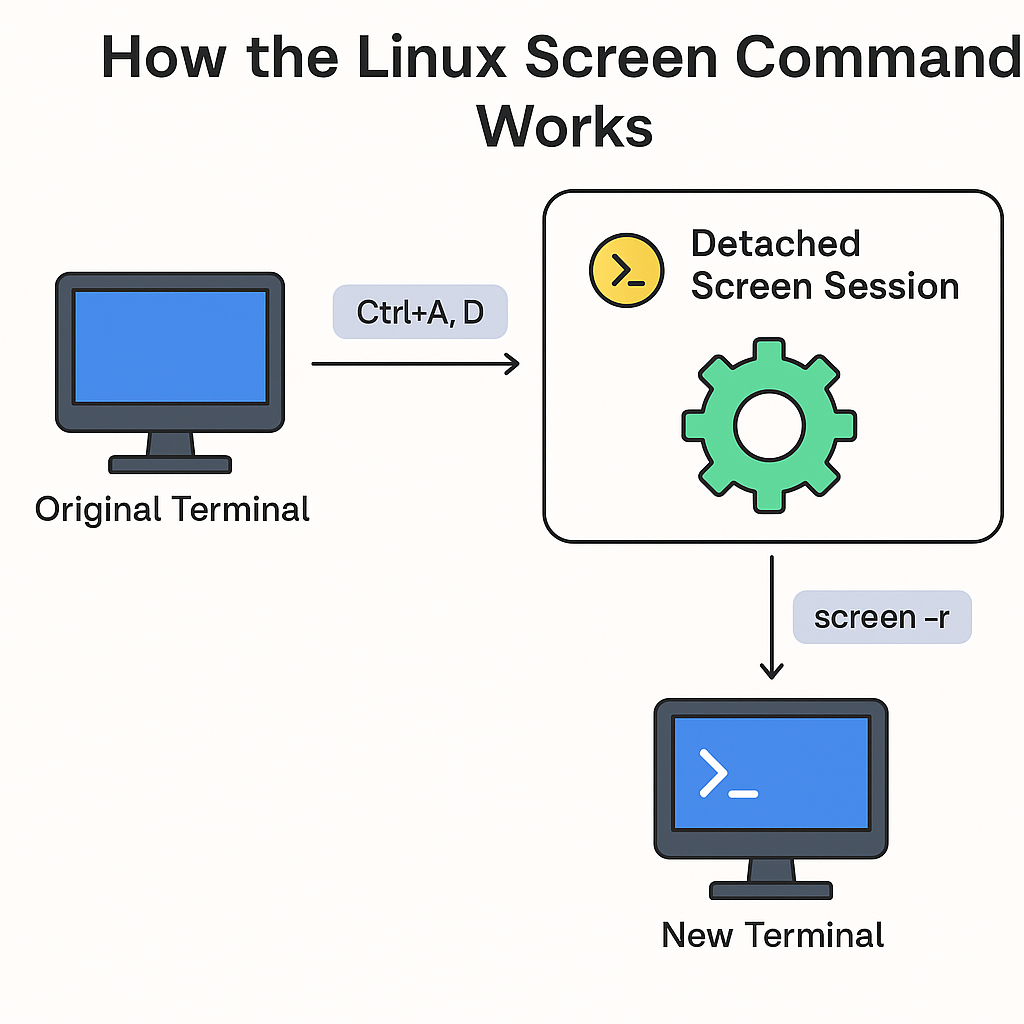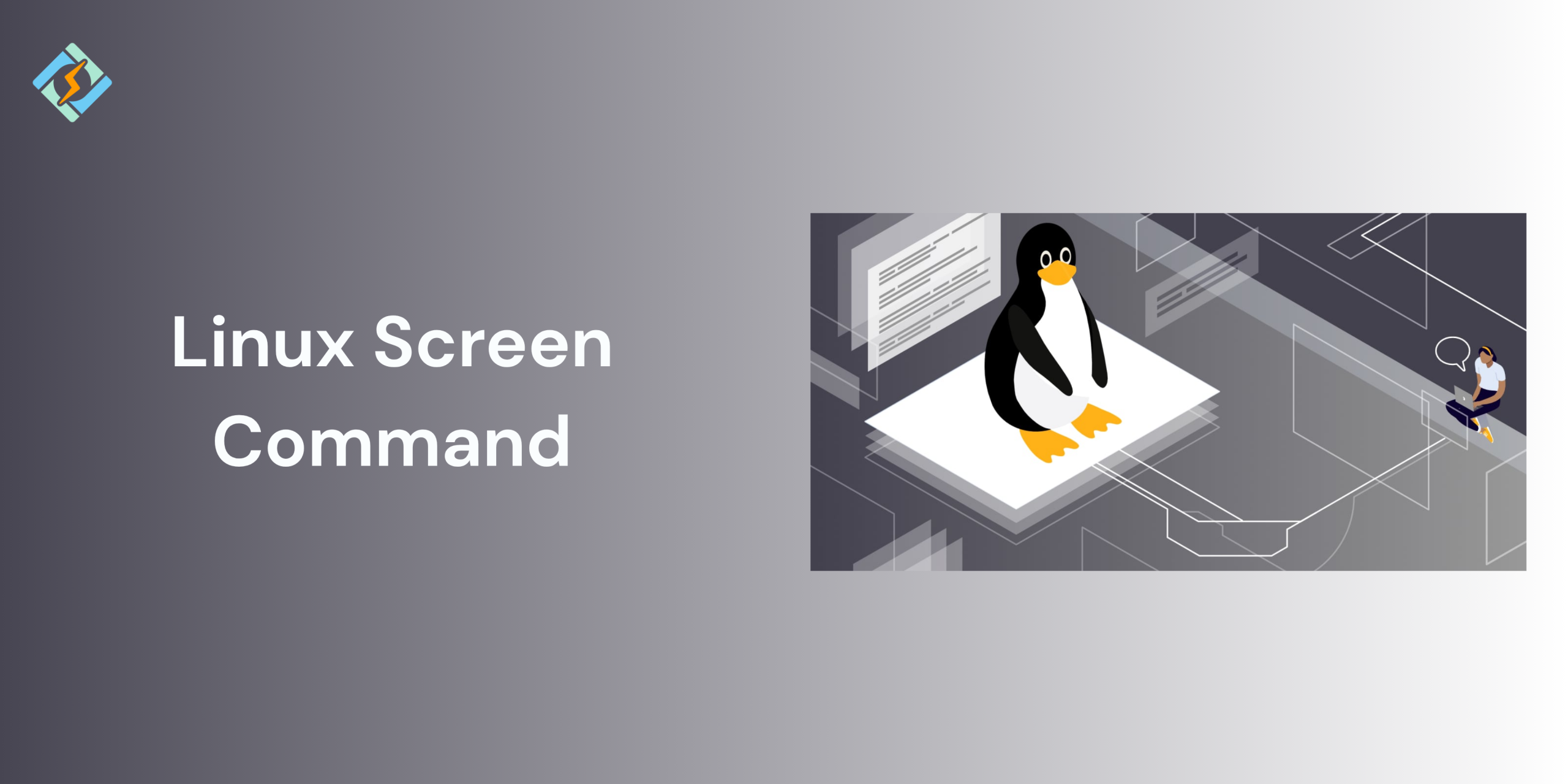As Linux users, we often face lengthy tasks like downloading large files or running slow queries, which can unexpectedly stop due to session timeouts. That’s when the Linux screen command comes into play!
It allows you to create persistent terminal sessions that remain active even when your connection is lost.
In this guide, I discuss everything about the Linux Screen command and how to use it efficiently in 2025.
What Is the Linux Screen Command?

The Linux screen command serves as a remote control for your terminal session. It allows you to create, manage, and reattach multiple terminal sessions within a single window. If you’ve ever experienced a loss of work due to an SSH connection failure or an internet outage, the screening tool is essential for your recovery.
Consider this: rather than juggling numerous open terminals and risking their loss during a disconnection or power failure, you can initiate a screen session and continue with your tasks at your convenience without having to start over. This tool is especially beneficial for system administrators, programmers, or anyone working with Linux remotely.
It’s similar to having “tabs” in your Linux terminal; you can open, detach, switch, or resume sessions whenever you want without losing your progress. This is especially useful for system administrators, developers, or anyone working remotely.
Get exclusive access to all things tech-savvy, and be the first to receive
the latest updates directly in your inbox.
Key Features of the Linux Screen Command
- Session Persistence: Keep programs running even after logging out.
- Multi-tasking Support: Open several terminal sessions at the same time.
- Terminal Splitting: View logs in one window while coding in another.
- Navigation Ease: Use keyboard shortcuts to switch between screens.
- Lightweight and Pre-installed: It is included by default in most Linux distributions.
Benefits of using a screen for long-running sessions
Linux Screen Command
- Execute terminal sessions in the background for lengthy scripts, updates, downloads, or server setups.
- Maintain program operation even if the internet connection is interrupted or terminated.
- Effortlessly toggle between various terminal windows, akin to having several browser tabs open.
- Reconnect to earlier sessions without losing any progress, no matter the device or if the computer restarts.
- Divide the terminal window to view system logs and edit files all within the same screen session.
How To Install a Screen on Linux
Installing the command screen Linux is a straightforward process. Let’s learn!
Basic Screen Command Syntax
screen [-opts] [cmd [args]]How to Install the Screen Command
Most Linux distros (Ubuntu, Debian, CentOS) include screen
sudo apt install screen
# For Debian/Ubuntu <br>sudo yum install screen
# For CentOS/RHEL 
How to Use Them To Start a session
1. Initiate a New Screen Session
To begin a new terminal screen session:
screen2. Assign a Name to Your SessionGiving a name to a session aids in managing multiple sessions.
screen -S file-S: This command starts a new window within the screen and assigns a name to that window. It creates a session that can be identified by that name, which can be used to reattach to the screen later.
2. Display All Active or Detached Screen Sessions
To view which screen sessions are currently active or have been detached:
screen -ls-ls: This option shows all currently opened screens, including those running in the background. It lists both attached and detached screen sessions.
3. Detach from a Screen Without Terminating It
You can leave a screen session running in the background by detaching it safely.

screen -d 1643- -d: This command detaches a screen session, allowing it to be reattached later. You can also use the shortcut key Ctrl-a + d for this action. Here, 1643 represents the screen ID you wish to detach.
4. Reattach to a Screen Session
To continue working on a previously detached session:
screen -r 1643-r: This command is used to reattach a screen session that was detached earlier.
Note:
To access the manual page for the screen command, use the following command:
man screenTo view the help page for the screen command, use the following command:
screen --helpWhich Linux Screen Commands You Need To Manage Your Screens?
| Option | Description |
|---|---|
-a | Forces all capabilities into each window’s terminal capability (termcap). |
| `-A -[r | R]` |
-c file | Uses a custom configuration file instead of the default .screenrc. |
-d (-r) | Detaches a running screen session from elsewhere and reattaches it here. |
-dmS name | Starts screen in detached mode with a session name (like a background task). |
-D (-r) | Detaches and logs out a remote session and reattaches it here. |
-D -RR | Does whatever is needed to connect to a screen session. |
-e xy | Changes the default control command characters. |
-f | Enables flow control. Use -fn to disable, or -fa for auto mode. |
-h lines | Sets the scrollback buffer size (number of history lines). |
-i | Interrupts output sooner when flow control is on. |
-l | Turns on login mode (updates /var/run/utmp). Use -ln to disable. |
-ls [match] | Lists all current screen sessions, with optional name match. |
-L | Enables output logging to a file. |
-m | Forces a new session to start while disregarding the variable. |
-O | Chooses optimized output over exact VT100 emulation. |
-p window | Starts the screen quietly. Returns error code if it fails. |
-q | Starts screen quietly. Returns error code if it fails. |
-Q | Pre-selects the named window when the screen starts. |
Key Takeaways
The Linux screen command functions similarly to a magical terminal pause button. Once you learn how to use it, you won’t want to return to standard SSH because it’s dependable and lightweight.
This tool can make the difference between a disaster recovery session and a productive day for developers, sysadmins, and anyone else working remotely on servers.
FAQ’s
1. What is the purpose of the Linux screen command?
The Command screen Linux establishes terminal sessions that are persistent, that is, they continue to function even after being disconnected.
2: How can I stop using a screen?
Hit Ctrl + A, followed by D.
3: Can I run more than one command on the screen?
Indeed. You can script your tasks or create windows within a session.
4: Is the Linux screen superior to Tmux?
Yes, for necessities. Although it has a learning curve, Tmux offers greater customization.
5: How can I end or terminate a screen session?
Press Ctrl + A and then K, or run screen -X -S session_name quit, after reattaching.



